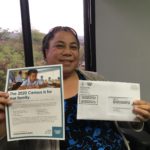The last day to respond to the U.S. Census is September 30, 2020, a month earlier than originally intended. The deadline was moved up, so there are only 3 weeks left to respond. The census is required by the U.S. Constitution to be done every 10 years, so it’s the law, but more importantly, there are significant benefits to each of us to responding.
Why respond? The number of people on the island determine how much federal funding our island and state get for COVID-19 Pandemic assistance, for schools and keiki and kupuna programs, for Quest (Hawaii’s Medicaid program), Medicare, hunger relief, for community hospitals, and more. The dollars that have come to Hawaii County for the current pandemic response are completely based on the 2010 U.S. Census, according to U.S. Representative Ed Case. In 2017, the State received around $5.8 billion from the Federal government, based on population counts.
And now, the State Department of Health’s new maps which show where COVID-19 cases are, are a great example of how the data might be used. The State DOH said, via an email from the State COVID-19 Joint Information Center, that they will no longer report cases in any zip code with fewer than 1,000 people. These are the affected zip codes:
Honaunau/Napoopoo (96726),
Honomu (96728),
Hakalau (96710),
Nīnole (96773),
Laupahoehoe (96764),
Welokā (96780),
Ookala (96774),
Mauna Kea reserve, PTA, and Hawaii Volcanoes National Park.
The census data used by the State is the count from the U.S. Census. Although all these zip codes do show populations of fewer than 1,000 — and that may still be the case–this highlights the many ways census data is used.
The Census will also determine the number of people on the island, and then a Redistricting Commission will re-draw County Council, State House, and State Senate district lines. The count also determines how many U.S. Representatives the State will have–the number currently being two.
According to the State Department of Business and Economic Development, more than 91% of Hawaii’s households have believed to have responded to the census, between those who “self responded” by filling in the census form online at www.2020census.gov or by phone to 844-330-2020. That is for English language, but the Census by phone is available for 12 other languages, plus there are written guides for 59 different languages. Click here for that information.
For people who have not yet responded, Census workers are going door to door. Census takers will wear masks and follow local public health guidelines when they visit your home. All census takers complete a virtual COVID-19 training on social distancing and other health and safety protocols before beginning their work in neighborhoods.
If the census taker who visits your home does not speak your language, you may request a return visit from a census taker who does speak your language.
Census takers work between 9am and 9pm, including weekends. If no one is home when the census taker visits, the census taker will leave a notice of their visit with information about how to respond online, by phone or by mail.
Photo is Sharlette Poe, a Waimanalo resident working now with the U.S. Census, holding up census forms.
